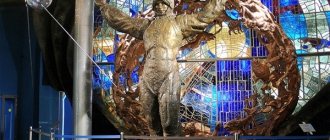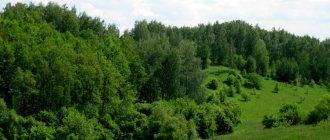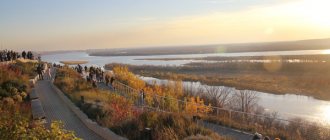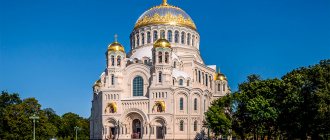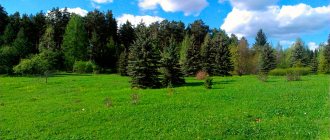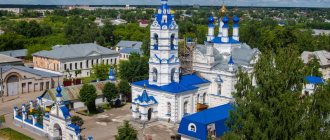Bryansk recreation centers attract many guests from other regions due to their beautiful nature and comfortable location. Most of the bases are located near the city limits, while cottages and hotels for accommodation are surrounded by dense forests with wonderful fresh air and clean bodies of water. Summer in the Bryansk region is not hot, which allows you to spend your holidays actively. The bases provide horseback riding, bicycle and ATV rental services.
Hiking through the forest allows you to better come into contact with picturesque nature. The healing pine air has a healing effect on the body of guests. You can enhance the healing effect by visiting a Russian wood-burning bathhouse. Several bases in the region offer guests fishing and hunting services with professional rangers. There are a lot of fish in the artificially stocked ponds, and the forests are rich in game.
Heroes' Memory Square
Following further along the fortress wall, we found ourselves in the park in memory of the Heroes. The red fortress wall, the eternal flame, it’s like walking around Moscow along the Kremlin. The square is dedicated to the feat of the heroes of the Patriotic War of 1812 and the Great Patriotic War of 1941-1945. The main dominant feature of the square is the monument “Grateful Russia - Heroes of 1812”. This is an impregnable rock that personifies Russia, an enemy warrior trying to conquer it, and two eagles defending their country.
Opposite the monument to the heroes of 1812 there is a museum “Smolensk region during the Great Patriotic War of 1941-1945”. The building is organically integrated into the fortress wall. Previously, there was the Smolensk City School, built on the site of the Kassandal Tower, blown up by the Napoleonic army during its retreat.
The alley of hero cities of the Great Patriotic War stretches from the eternal flame to the museum. 13 steles with the names of cities and the image of the Gold Star medal.
From the monument “Grateful Russia - Heroes of 1812” to Dzerzhinsky Street there is an alley in which busts of generals of the Patriotic War of 1812 are installed.
Eternal Flame Eternal Flame Monument to Grateful Russia - Heroes of 1812 Monument to Grateful Russia - Heroes of 1812 Generals of the Patriotic War Generals of the Patriotic War
Nerusso-Desnyanskoye Polesie
This biosphere reserve is part of the protected areas under the auspices of UNESCO. Its core is considered to be the Bryansk Forest Nature Reserve, which occupies an area of 12,186 hectares. In the west, Nesrusso-Desnyanskoye Polesie is limited by the Navlya River, and in the north by the Desna. On the territory of the main natural attraction of the Bryansk region, 37 species of trees and 39 varieties of shrubs grow. Mostly you can see pine, oak, ash, birch, aspen and spruce. The fact that Nerusso-Desnyanskoye Polesie is the only remaining natural habitat of all 10 species of European woodpeckers deserves special mention.
Contrary to the opinion of some Russians that bison live in the Bryansk Forest, they cannot be seen there. The fact is that the experiment to resettle these animals into the region, which began in 1996, failed. Due to the lack of usual pasture, bison began to raid vegetable gardens in villages located around the Bryansk Forest. When they were forced to move away from human habitation, the animals began to die one after another from accidents and due to the fault of poachers.
Animal world
A visit to the main natural attraction of the Bryansk region - Nerusso-Desnyansky Polesye - will be interesting for those who like to watch wild animals in their natural habitat. The reserve is currently home to 500 species of insects, 30 species of fish, 12 amphibians and 10 birds. Among the mammals living there, one can note white-breasted hedgehogs, common shrews, moles, wood pipistrelles, water bats, two-colored leopards, wolves, foxes, pine martens, moose, wild boars, red deer, roe deer, white hares, common squirrels, river beavers, red and water voles and yellow-throated mice.
Eco-excursions
To see the most interesting natural attractions of the Bryansk region, it is best to visit the Nesrusso-Desnyanskoe Polesie reserve as part of an organized group. The excursion along the 640 m long ecological trail “Our Home – Bryansk Forest” is very popular. It runs on a wooden floor equipped with a full house and has a duration of 1 hour 20 minutes.
During the excursion, tourists are introduced to the history of the reserve and the habits of its inhabitants. Since the trail runs along the valley of the Terebushka River, visitors to the reserve can see traces of beaver activity. At the end of the excursion, tourists are invited to watch a film about the animals that inhabit the Bryansk Forest, created on the basis of video materials obtained using camera traps installed on the territory of the reserve.
"Partisan Stories"
When talking about the natural attractions of Bryansk and the Bryansk region, one cannot fail to mention the powerful patriotic movement that arose in the local forests during the Great Patriotic War. You can learn more about it by taking part in the “Partisan Stories” excursion, which takes place along a specially equipped path near the village of Smelizh.
During the walk, tourists are told real stories from the lives of 13 partisans who fought in these places. The trail ends at a reconstructed dugout that housed a partisan hospital. In addition, participants are shown a stele erected in honor of the first performance of the famous song “The Bryansk Forest Made a Harsh Noise.”
Cities
Where to go for a weekend from Bryansk? We invite you to visit new cities. Read about travel from Bryansk. Choose your favorite city. Find out what to see and where to stay. For each route there is a calculation of distances and travel time, GPS coordinates, photos and descriptions. Take advantage of the convenient sorting of routes by type of recreation or distance from Bryansk. Choose on our website where to go for the weekend from Bryansk. We wish you pleasant reading, new travels and impressions.
Eastern part of the Smolensk fortress wall
On the second day we planned to visit the longest surviving section of the Smolensk fortress wall. Its length is almost 1.5 km. This part of the fortress protected the city from the east. The wall runs along Marshal Zhukov and Timiryazev streets. There are 9 towers preserved here. Each tower of the Smolensk fortress wall has its own name. They are all different in shape and height. There are no identical towers in the fortress. The most famous towers on this site are Orel and Veselukha. The Eagle Tower is easy to recognize - it is the only one standing without a roof. During restoration work in 2012, a fire broke out in the tower. The roof was never built. For several years they did not return to restoration, and in 2015 the tower was simply walled up. So it stands without a roof. Its shape resembles the tower of a medieval castle.
Eagle Tower Eagle Tower
The Veselukha Tower is the last one on this section of the wall. It owes its name to the beautiful view of the Dnieper River and the city that opens from its height. Now you can't climb the tower. But even from the hill on which it stands you can see a beautiful panorama of Smolensk.
Veselukha Tower Veselukha Tower View of Smolensk View of Smolensk
We began examining the eastern section of the wall from the inside. This is not very convenient to do. Often the wall is hidden behind various buildings, fences, and closed areas. The sidewalk along Marshal Zhukov and Timiryazev streets sometimes turns into a narrow strip about 30 centimeters wide, and sometimes it doesn’t exist at all. We walked back along the outside of the wall. There, nothing interfered with the inspection of the fortress, because there was nothing behind the wall except paths, grass, trees, bushes and ravines. Here you can calmly walk, enjoy the view and imagine how the enemy approached the high walls of the fortress, how they tried to capture the city. There are passages in the wall in several places, so you can move from one side to the other.
Thunder Tower Museum
The next stop on our route was the Thunder Tower Museum. This, as we understood, is the only opportunity to visit inside the tower and climb the fortress wall. The museum is small but incredibly atmospheric. Narrow stairs and passages, heavy wooden doors. 3 floors, each with its own exhibition. Most of all I liked the model of the Smolensk fortress wall. I generally have a weakness for all kinds of miniatures. And here is the opportunity to see the entire fortress wall. All of its 38 towers, of which only 18 have survived. You can imagine the scale of construction. How many people and funds were needed in order to in the 16-17 centuries. build such a monumental structure. The length of the wall was 6.5 km, width – 5.2-6 m, and height – 13-19 m. In the museum you can climb under the roof of the tower and go out onto the fortress wall. When you are inside, the roof seems very high. It is made of logs, and the outside is covered with boards. Souvenirs are sold on the ground floor of the museum. We bought a magnet with a picture of the Smolensk fortress wall as a souvenir.
Thunder Tower Thunder Tower Model of the Smolensk fortress wall Model of the Smolensk fortress wall
Lenin Square
The center of Smolensk turned out to be very beautiful and cozy. The city's architects managed to preserve its historical appearance. Here you will not find modern high-rise buildings, office centers made of glass and concrete. You walk around and stop at almost every house to look and take pictures. No, of course, if you go a little further there will be the usual Soviet five-story buildings with shops on the ground floor with colorful signs, and the private sector, and other delights of life. But the center itself and several blocks around are elegant and beautiful.
Travel budget
When planning a trip to Smolensk, we expected to spend 5,000 rubles.
- 2,000 – gasoline
- 1 600 – apartment
- 1 400 – food
In fact, it came out to almost 6,000 rubles. We decided to order rolls for 1,000 in the evening. But it would have been 5,000. Considering that we lived in an apartment, we could cook the food ourselves. We did that once, and then we were too lazy. Who wants to cook while traveling? Although cooking dumplings or sausages with pasta is not difficult.
How to get from Bryansk to Smolensk
- by car;
- by bus;
- by train;
- on the way.
By car we drove from Bryansk to Smolensk in 3 hours. By bus, the journey will take from 3 to 5.5 hours, depending on the route chosen. More than 10 buses run on the Bryansk – Smolensk route per day. The train ride from Bryansk to Smolensk takes 5 hours. But the train runs once a day and not every day, so it is not the most convenient way to travel along this route. Hitting a ride will take the same amount of time as driving a personal car. There are special services for finding travel companions. This way you can save a lot on the road from Bryansk to Smolensk.
City Garden named after. M.I. Glinka
Then we headed back to Lenin Square. Along the way we admired the beautiful houses. We went to the city garden named after. M.I. Glinka, founded back in 1830. We took a walk around the fountain. My son liked the bronze sculptures of a deer and two lions. These sculptures were taken as trophies after the Second World War from the dacha of Hermann Goering, one of the most famous leaders of Nazi Germany. This ended our walk on the first day.
Square of victory
From the Heroes' Memorial Square we headed to Victory Square. It is located across the road (Gagarin Avenue). In the center of the square is a monument to the defenders of Smolensk. It was installed in 2015 and dedicated to the memory of participants in the Russian-Polish War of 1609-1611, the Patriotic War of 1812 and the Great Patriotic War of 1941-1945. A section of the fortress wall has been preserved on the square. The oldest cinema in the city, “October,” is also located here.
Victory Square Victory Square
Sights, photos of the city of Bryansk
In the administrative center of the region, tourists can:
- Visit the Nightingales park. On its territory there is the Mound of Immortality, which is based on the soil from all the graves of soldiers who died for the freedom of their native country. In addition, “Nightingales” has an observation deck from which you can take beautiful panoramic photographs of the city.
- Visit the Renaissance Temple (address: Bezhitskaya st., 263). The church is surrounded by forest, and you can take great photographs against its background. In addition, the church hosts sacred music concerts from time to time.
- Inspect the Gorno-Nikolskaya Church (address: Arsenalnaya St., 8). The temple was built in 1751 in the Naryshkin Baroque style and is located on a hill located opposite Pokrovskaya Mountain.
- Climb to the Pokrovskaya Gora complex. There is a monument on it in honor of the 1000th anniversary of the city, and just below the monument to the hero Peresvet.
Review of 10 popular tourist spots that you must visit
Despite the fact that you can tour the main attractions of the region in a week, you won’t be able to see everything in a short period of time. Therefore, for future travelers, I have selected a list of interesting places to visit in the Bryansk region.
Bryansk Forest Nature Reserve
Founded in 1987. Its total area is 121 sq. km.
Here you can look at such beautiful natural monuments as:
- "Goremlya";
- "Well" and others.
In addition to hares, foxes and moose, the reserve also contains bison. Here alone, ornithologists have discovered 10 species of European woodpeckers.
Vshchizh
This village is located near Zhukovka. In the 40s XIX, archaeological excavations began on the territory of the village, as a result of which scientists found the ruins of an ancient cathedral. Moreover, some of the interior decoration was preserved; the crypt turned out to be practically intact.
In the 20th century archaeologists managed to discover a sanctuary-fortress, and at the beginning of the 21st century. - a boat, the length of which was 9 m. Despite its historical value, the territory is not protected by the state, no restoration work is being carried out.
Museum-Estate of A.K. Tolstoy
It is located in the regional center. The open-air museum was founded in 1936 on an area of 3 hectares. On its territory there are many wooden sculptures, including “Desnyanka”, “Emelya”, “Bryansk Madonna”, etc.
You will also like: Top 10 main attractions of Vyborg
The estate has 3 fountains, attractions and a summer stage. You can also visit the temple and have lunch at the cafe. The place is considered both a historical monument and a recreation area.
Zavadovsky Estate
Built in the 18th century. the estate belonged to Count P.V. Zavadovsky. On the territory there were various buildings and a mansion.
Now only ruins of the buildings have survived, but local authorities have begun restoration work. First, it is planned to restore the Church of St. Catherine, and after that - the rest of the buildings.
Memorial complex "Hatsun"
Located on the territory of a village whose inhabitants were killed by German soldiers at the beginning of the Great Patriotic War. It was founded in 1977 and restored in 2009.
Museum exhibitions are divided into 2 parts:
- pre-war time;
- events that occurred on October 25, 1941
The complex is dedicated not only to Hatsuni, but also to other settlements in which the Nazis showed cruelty against civilians.
The map created by the museum shows about 1,000 villages that suffered from the invaders.
Mound of Immortality
Located in the regional. Formed in 1972 in memory of the soldiers who died during the Great Patriotic War. An 18-meter star was installed on it. The height of the embankment itself is 12 m.
An observation deck is equipped for visitors, from which you can see the surrounding landscapes, incl. The banks of the Desna River are clearly visible. Near the Mound of Immortality there are cafes and attractions, so tourists can not only honor the memory of the warriors, but also relax.
Lake Svyatoe
This lake, located in the Zhukovsky district, is considered one of the 4 “holy” reservoirs of the region. Its exact depth has not been measured, since the bottom is covered with a thick silt layer, however, according to available information, it is at least 18 m. The water itself is transparent and clean.
There are many legends about the lake. One of them says that there used to be a church on this site, which one day simply went under water for no apparent reason - there were no cataclysms. Local residents say that at night bells can be heard from the direction of the lake.
Eyewitnesses claim that UFOs are often seen over the pond.
Nikolo-Odrinsky Monastery
Built in the 13th century. Located in the village of Odrina. Is feminine. During the years of Soviet rule, it was given over to a colony for minors; it was also a training ground for military exercises.
You will also like: Old Izborsk attractions: in one day, waterfalls, beautiful places
In 1995, the site was again taken over by the nuns. I saw a shrine here - the “Helper of Sinners” icon, the first mention of which dates back to 1843.
Svensky Monastery
This monastery is located in the village of Suponevo. The construction of the monastery dates back to 1288. According to legend, it was erected in connection with the appearance in these places of an icon that restored sight to Prince Roman.
After the revolution that took place in 1917, the buildings located on the territory were blown up or destroyed. Only in the 90s. XX century the monastery began to be restored. The restoration ended in 2014. However, the icon of the Mother of God was not returned and is now kept in the Tretyakov Gallery.
Other attractions of the Bryansk region with descriptions
Due to its border status, the region has been constantly attacked and suffered from armed conflicts. In this regard, the historical and cultural sights of the Bryansk region are not distinguished by their antiquity. However, lovers of educational excursions are welcome there:
- Monument of Friendship in Klimovo. This composition was installed to remind of the inviolability of friendship between Russians, Belarusians and Ukrainians at the place where the borders of three countries intersect.
- A. Tolstoy Sculpture Park in Krasny Rog (Pochepsky district). It belongs to the museum of the famous writer; its visitors enjoy taking photographs against the backdrop of wooden compositions carved from the trunks of dried trees.
- Memorial complex in Hatsuni. This mournful place serves as a reminder of how in 1941 the Nazis killed about 1,000 local residents for 3 German soldiers killed by partisans.
Now you know where the most famous natural attractions of the Bryansk region are located. There are interesting places in every corner of Russia, so domestic tourism in our country has huge untapped potential.
Museums and theaters of Bryansk
Among the city's guests, the park-museum named after. A. Tolstoy. Here you can see numerous wooden sculptures depicting fairy-tale characters, historical figures and animals . Every tourist considers it his duty to take a photo with the Bryansk wolf.
The centuries-old history of the city is displayed in the Bryansk Museum of Local Lore. The Bryansk Literary Museum, which tells about Bryansk writers and poets, is located in the building of a former merchant mansion. Rare publications by A. Tolstoy and F. Tyutchev are stored here.
An acquaintance with the museums of Bryansk would be incomplete without a visit to the Partisanskaya Polyana memorial complex. Here you can see a real dugout, weapons from the Second World War, obelisks... This complex houses a museum of the partisan movement, where you can not only get acquainted with the stages of the development of popular resistance in the Bryansk region, but also see the diorama “The Explosion of the Blue Bridge,” depicting an episode of the famous partisan operation.
The Bryansk Art Museum and the Tkachev Brothers Museum will also be interesting to visit. If you travel around the Bryansk region, be sure to visit the Ovstug Museum-Reserve, located on the former estate of F. Tyutchev.
The symbol of local performing arts is the Bryansk Drama Theater. A. Tolstoy. On its stage you can see works by world and domestic classics. The puppet theater, the theater for young spectators and the Orpheus theater are no less popular. Concerts of various levels, including all-Russian festivals, are held in the Druzhba concert hall.





